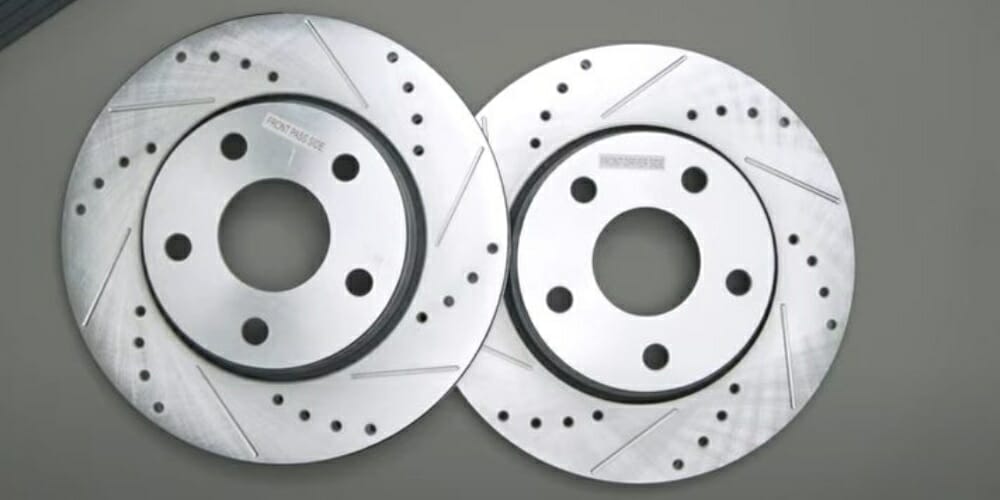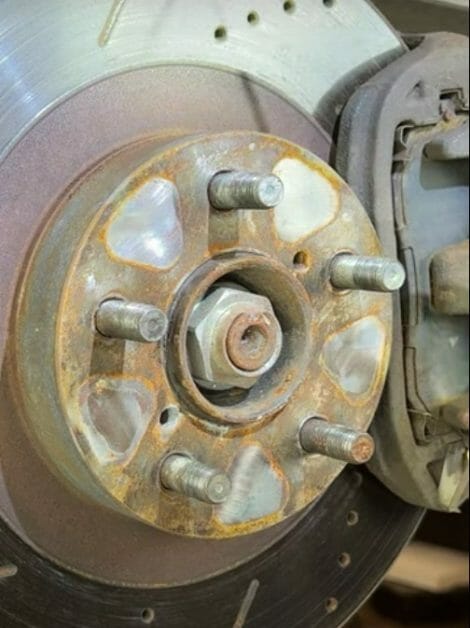Do Drilled and Slotted Rotors Make Noise? (Guide)

Let’s explore a topic that’s as intriguing as practical: Do drilled and slotted rotors make noise? I’ve been around the block several times and heard many tales about these high-performance rotors.
Well, it’s not a simple yes or no. From what I’ve gathered, the design of drilled and slotted rotors can sometimes produce a bit more noise than a standard rotor.
I’m here to cut through the noise and get down to the nitty-gritty. We will explore the science behind these rotors, what makes them tick, and most importantly, whether they’re the quiet achievers or the loud neighbors of the automotive world.
Understanding Drilled and Slotted Rotors

Let’s dive right into the heart of the matter, shall we? I was as curious as a cat when I heard about drilled and slotted rotors. It turns out these rotors are all about performance.
Picture this: you’re driving, and suddenly need to hit the brakes—hard. Your car’s rotors work with the brake pads to bring your vehicle to a stop.
But here’s the kicker, regular old rotors can get super hot, leading to brake fade. That’s where drilled and slotted rotors come in.
The drilled holes and slots in these rotors serve a dual purpose. First off, the drilled holes allow heat to escape. This means your brakes stay cooler, work better, and you get a smoother ride.
Then there are the slots. They’re not just for show. They help wipe away debris and gases that can build up between the brake pad and the rotor. It’s like giving your brakes a clean surface to work with every time you hit the pedal.
In essence, these rotors are about maximizing performance. Whether you’re a casual driver or like to push your car a bit, understanding the mechanics behind your vehicle can change the game.
Noise Characteristics of Drilled and Slotted Rotors

Let’s discuss something many of you asked me about—the noise levels of drilled and slotted rotors. You know, it’s a bit like adding a high-performance exhaust. Sure, there’s more rumble, but it’s music to the ears of car enthusiasts.
First, I’ve got to say drilled and slotted rotors are indeed noisier than standard rotors. It’s not your imagination. While awesome for cooling and wiping away debris, the design creates a distinctive sound.
You might wonder, “Why do they make more noise?” The holes and slots in these rotors create air turbulence and vibration as the brake pads clamp down on them.
This action generates a unique sound. But here’s the interesting part—the noise can be a good thing. It’s like an immediate feedback system, letting you know your high-performance brakes are working as they should.
I’ve heard from some of you that the noise can be a bit loud at first. But, like anything else, it’s all about what you’re used to. After a while, many drivers associate the sound with their vehicle’s improved performance and safety.
It becomes less of an annoyance and more of a badge of honor—you’re driving something upgraded for better performance.
So, while it’s true that drilled and slotted rotors are noisier, remember why you opted for them in the first place. It’s not just about making a statement with your ride but also about enhancing its performance in a tangible way—from the grip on the road to how quickly you can stop when it matters most.
Comparing Noise Levels: Drilled and Slotted vs. Standard Rotors
Let’s dive into the nitty-gritty of drilled and slotted rotors versus the standard ones.
First, let’s talk about the standard rotors. These are your typical, everyday rotors that come standard on most cars. They’re like the reliable buddy who’s always there for you, no questions asked.
They do their job quietly, without any fuss. That’s the thing—they’re designed to be quiet. When you hit the brakes, their smooth surface means less air turbulence and noise.
Flip the script and think about drilled and slotted rotors. These bad boys are all about performance. Imagine them as the high-octane, turbocharged version of brakes.
They’re designed with holes and slots that cut through the gas and dust created by brake pads, like a hot knife through butter. This design improves braking performance and adds some auditory feedback.
Here’s the thing – that noise you hear isn’t just any noise. It’s the sound of enhanced performance. The air turbulence and vibration from the slots and holes create a distinctive sound similar to a performance exhaust.
It’s not just noise; it’s a symphony of high performance and improved safety. For performance enthusiasts, it’s like music to their ears.
For those who prefer a quieter ride and are content with standard performance, stick with the good old standard rotors. Remember, it’s all about what suits your style and ride’s needs.
Drilled and Slotted Rotors Maintenance Schedule
You want your ride to stop on a dime without that concert of noise. Let’s dive in with a clear-cut maintenance schedule and checklist that’ll keep your brakes performing like the rock stars they are.
| Frequency | Maintenance Task | Details |
|---|---|---|
| Monthly | Visual Inspection | Check for signs of wear and damage, and ensure the rotors’ surface is even. Look for uneven wear, deep grooves, or cracks. |
| Cleanliness Check | Use compressed air to clear debris from the drilled holes and slots, promoting effective heat dissipation. | |
| Every 6 Months | Thickness Check | Measure the thickness with a micrometer and compare to the manufacturer’s minimum specification. If close to the limit, consider replacement. |
| Pad Check | Inspect the brake pads for wear and ensure they are wearing evenly. Replace if necessary to avoid noise and ensure effective braking. | |
| Annually | Professional Inspection | Have a professional inspect the braking system for any potential issues that might have been overlooked during personal checks. |
| Rotor Resurfacing | If the rotors show signs of wear but are above the minimum thickness, consider resurfacing to extend their lifespan and improve braking performance. | |
| As Needed | Listen and Feel | Pay attention to changes in braking noise and pedal feel. These could indicate it’s time for maintenance or replacement. |
| Replacement Time | Replace rotors that have reached or surpassed the wear limit specified by the manufacturer or if inspection reveals damage that cannot be corrected through resurfacing. |
Adhering to this schedule will ensure your vehicle remains safe and reliable and help maintain the performance edge that drilled and slotted rotors provide. Remember, regular maintenance is key to vehicle safety and efficiency.
Frequently Asked Questions
- Can the Drilled and Slotted Rotors Stop Brake Pads from Torching or Glazing?
- The design of drilled and slotted rotors aids in disengaging some pads from the glazing. The pad merges part of itself into the disc if there is constant friction, resulting in performance loss. The slots on a rotor sever the connectivity of the pad, providing key momentary stops in contact that prevent the process from occurring.
- What’s the Cost of Replacing Drilled and Slotted Rotors?
- You can quickly find cheap rotors for around $60 and performance drilled and slotted rotors for around $150. Many rotors, including rear rotors, are priced as high as $100, but you can find a good set of economy rotor blades in the $70 range. You should expect to pay around $90-$120 per blade for high-quality, expertly-made rotor blades.
- Do Drilled and Slotted Rotors Increase Brake Pad Wear?
- In reality, drilled and slotted rotors can lead to more efficient heat dissipation, reducing the potential for brake pad glazing and, in turn, extending pad life. Ensure those pads are compatible with your high-performance rotors for the best results.
- Are They Suitable for All Driving Conditions?
- Drilled and slotted rotors are designed for the long haul, whether navigating the daily commute or hitting the track on the weekend. They’re especially adept at keeping brakes cool under high-stress conditions. However, it’s important to remember that extreme conditions, like those found in racing, may require more frequent inspections and maintenance.
- Can Drilled and Slotted Rotors Improve My Vehicle’s Performance?
- These rotors aren’t just for show. You’re looking at enhanced braking performance, and response by reducing brake fade through improved heat dissipation and preventing gas build-up between the pad and rotor. This can make a noticeable difference in daily and more spirited, performance-oriented driving.
- How Often Should I Replace My Drilled and Slotted Rotors?
- Keep tabs on the thickness and overall condition of your rotors. If they’re worn down to the manufacturer’s specified minimum thickness or show significant damage, it’s time for a change. Regular inspections will be your guide here.
Resources
Organizations
- National Highway Traffic Safety Administration (NHTSA) – https://www.nhtsa.gov/
- Automotive Aftermarket Suppliers Association (AASA) – https://automotiveaftermarket.org/listing/aasa/
Books
- “Brake Handbook” by Fred Puhn – https://books.google.com/books/about/Brake_Handbook.html?id=zE0OAAAACAAJ
- “Automotive Braking Systems” by James D. Halderman – https://books.google.com/books/about/Automotive_Brake_Systems.html?id=9sVPAAAACAAJ
Website Resources
- Car and Driver – https://www.caranddriver.com/
- Motor Trend – https://www.motortrend.com/
- Brembo – https://www.brembo.com/en
Video Reference
Counterman
Easy Fix
